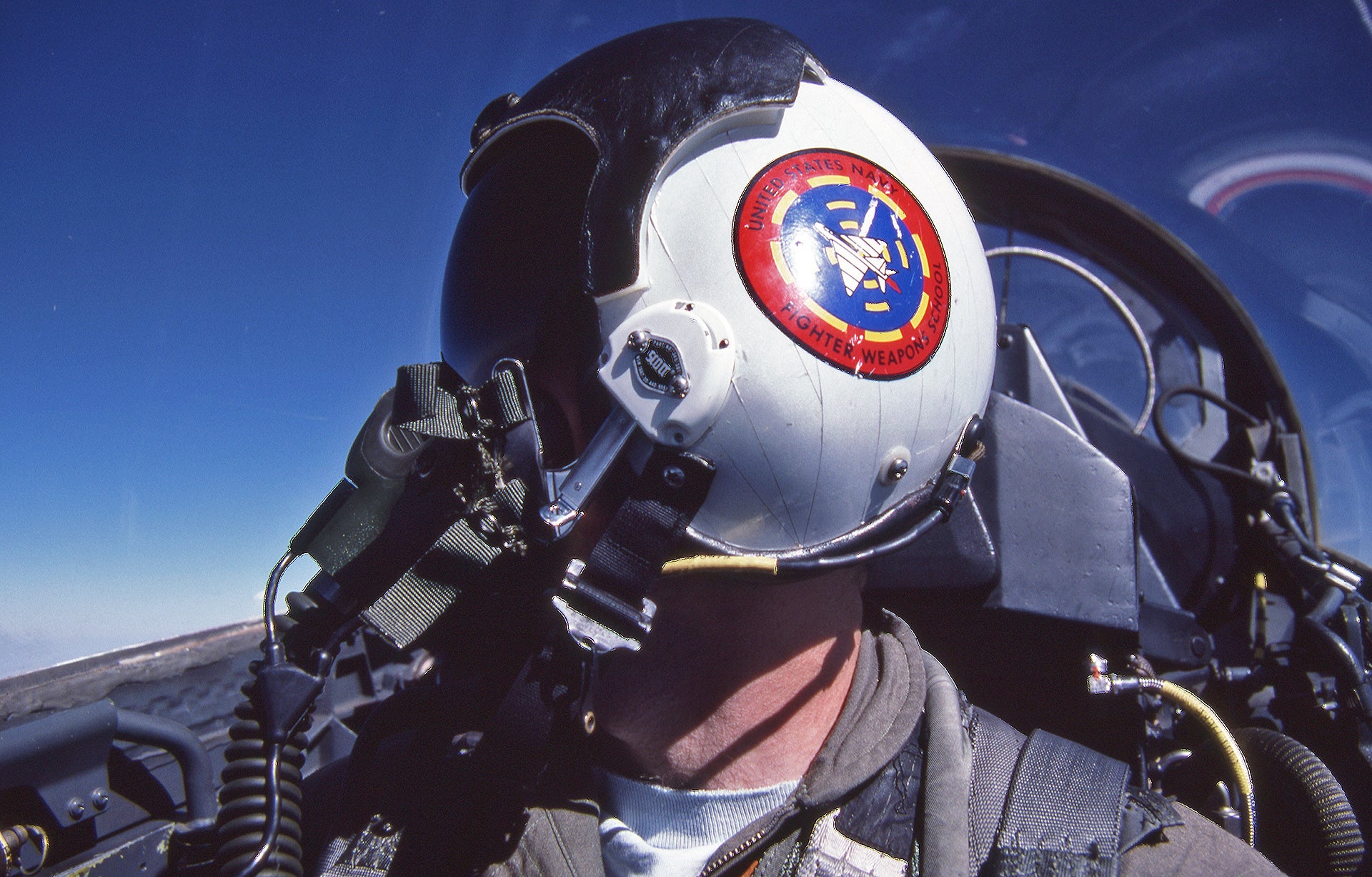At height of the Cold War, and just months before the public’s perception of US Navy tactical aviation would be forever changed by the blockbuster action movie Top Gun, F-14 Tomcat pilot Paul Nickell would arrive on Topgun’s doorstep. After graduating from the elite fighter weapons and tactics school, Nickell would become an instructor there himself, flying against student pilots in the same F-5s and A-4s that had taxed him and his Tomcat to the max just months before.
In the second in our three part in-depth series about Paul’s experiences flying fighters for the US Navy in the 1980s, he tells us how to fight and win in some of Topgun’s most iconic jets, and what it was like to attend and later teach at the legendary US Navy Fighter Weapons School.
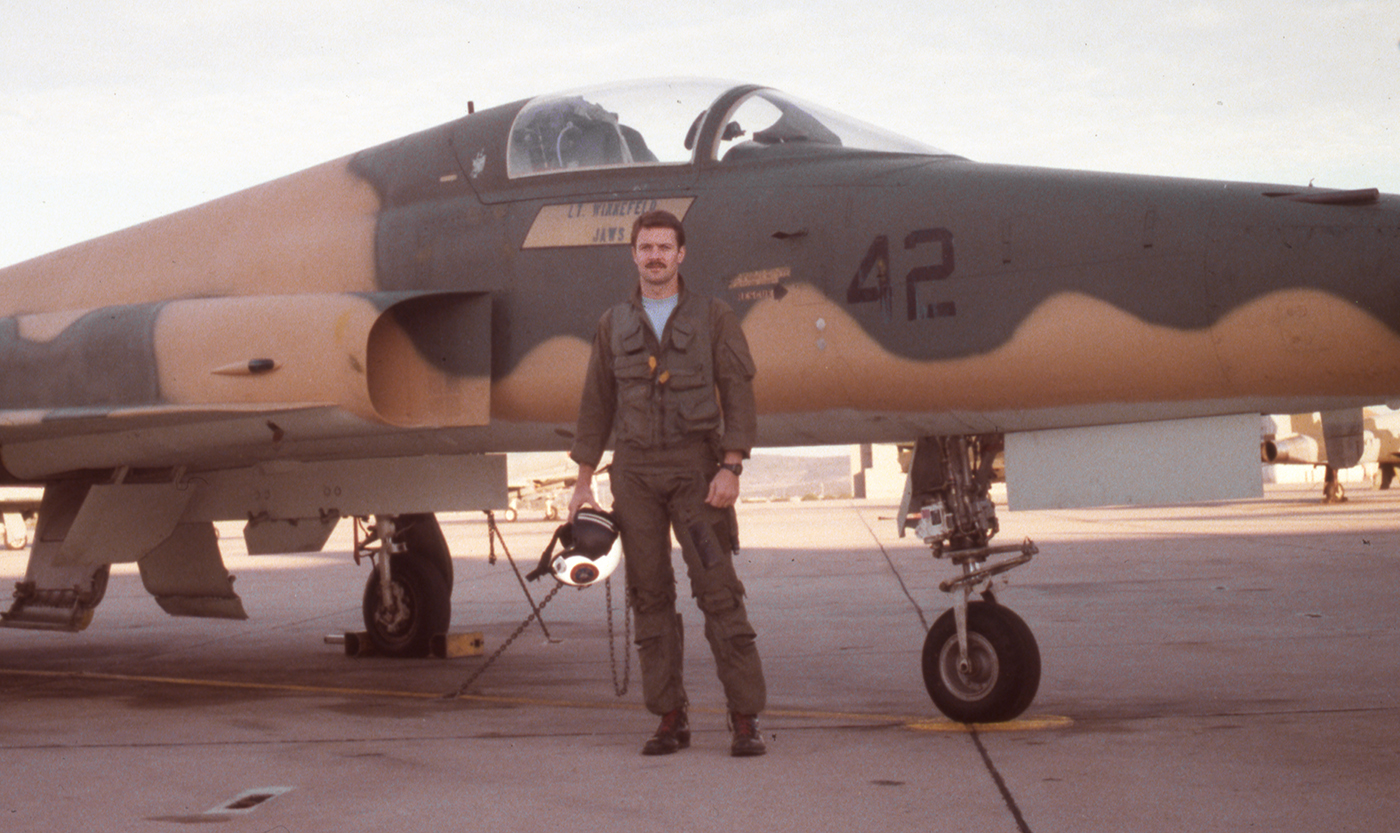
Showing up to the first day of school
I think it was the second oldest hangar at Miramar, but it was designated Hangar One. It sat at the east end of Runway 24 Right, just to the north of the hold short line. Most likely built in the 1950s, it wasn’t there in the early 1940s when my dad was stationed at then Camp Kearny as a B-24 radioman. It had survived a flamed out pilotless F-8 Crusader crashing into it in December of 1969, a tragedy that took 14 lives.
Across the north side of the hangar, facing the road, in huge deep-blue block letters was the word “TOPGUN. At the time, Topgun was not a household word. The average American had no idea what it was, but that would change soon. After parking in the lot across the street, we walked past a couple of large dumpsters on the side of the parking lot entrance, crossed the street, climbed a few steps and returned a salute from the gate guard. About 50 feet away, in the northeast corner of the hanger, was a single width blue metal door. Above the door was a white metal sign screwed to the corrugated grey metal siding which read “WELCOME TO NAVY FIGHTER WEAPONS SCHOOL” in black stenciled letters. In the center of the sign was a large sticker of the Topgun emblem.
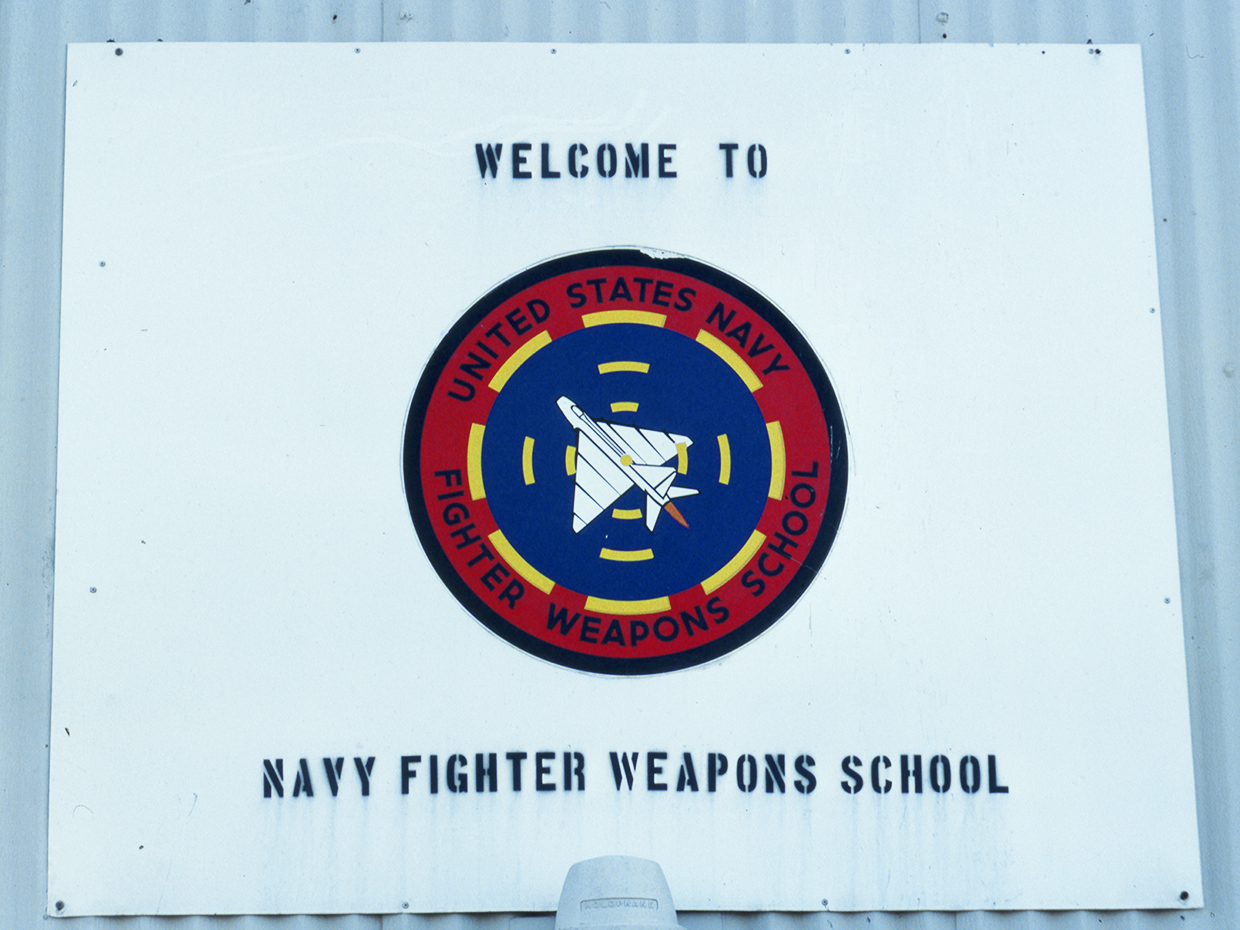
Entering the door, we were in a stairwell that went half way up and then switched back to complete the journey to the second level. The walls of the stairwell were painted gloss white and were covered with neatly spaced red silhouettes of MiG aircraft kills from Vietnam. Below each were the aircrew names and the date of the kill. Additionally there were two recent silhouettes from Libya.
At the top of the stairs we turned left and started down a hallway. The right side was solid and was the exterior wall of the hangar. There was one opening on the right, about the size of a double door, with an accordion metal contraption across it so that no one would accidentally walk out the opening and fall 20 feet to the ramp below. The remainder of the wall was covered with a small group of pictures of the current Topgun staff and plaques.There were several rows of plaques that ran the length of the hallway, probably 100 yards or more. Each plaque was a gift from a crew that had attended training at Topgun, and each had a unique story behind it. There were literally hundreds of them.

Down the left side of the hallway were the squadron spaces. The CO and XO offices were first with a secretary in front. There was a small ready room where the Squadron Duty Officer sat during flight ops. There were several small groups of briefing and debriefing rooms, along with two relatively large classrooms. Beyond that was the operations office and the training office. We were directed into Classroom One which was walled with 4X8 sheets of imitation wood paneling. There were tables and chairs to seat about 35 students plus a row of chairs with no tables across the back for additional guests. The left side of the classroom had a single air conditioning window unit that dumped the heat and humidity from the classroom into the hangar. There were a few large TV’s in the corners. At the front of the classroom was a whiteboard, a podium, and an opaque plastic screen that slides could be projected onto from behind. At numerous places around the room there were models of different types of US and threat fighter aircraft attached to wooden dowels that could be used for briefing and debriefing purposes. Most of the furnishings of this room and the rest of the spaces had probably been lifted from somewhere else on the base, or traded for through the navy supply system. Obviously none of it appeared nice enough to have had origins on an Air Force base. We found our places at a table denoted with paper name tags and a stack of handouts for each of us.
It was day one of Topgun.
Putting Topgun’s lessons to use
The course progressed in a logical fashion. The first two days were filled with lectures. From day three on, most days began with a lecture, followed by multiple flights. Week one flying was all 1 V 1 against A-4E’s and F-5 E/F’s. Week two involved 2 V 2 and 2 V Unknown missions. As the weeks progressed, the missions got larger and more complex until the final class “Alpha Strike” mission. We had a number of memorable flights, but for me, the following were the most memorable.

Somewhere around Friday afternoon of week three we flew our final 1 V 1 flight, otherwise known as “Grad 1 V 1.” Unlike all of the previous 1 V 1 missions that we had flown in week one, for Grad 1 V 1 all instructors and all crews briefed in one large classroom. Additionally there were unknown Air Force and Marine pilots, and a couple of other unknowns gents in flight suits. At the end of the briefing, the Rules of Engagement (ROE) were briefed and concluded by one crew member from each type of aircraft briefing the stall/spin recovery procedures for their type. The types of aircraft going through the class and those flown by the instructors were recited, followed by the Air Force pilots reciting F-15 and F-16 procedures, and the others briefing P-51 and F-86 procedures. At that point all participants were handed a sealed envelope, and the briefing was complete.
Inside each envelope was a card that told us our “Goon” callsign, which warning area and which end of that warning area to go to, and what time to be there. Unlike all of our previous 1 V 1s, we had no idea what type of aircraft we would be fighting, and since these engagements would start with an intercept, we would not know until the merge.
After the brief we drove down to the VF-24 (my Tomcat squadron at the time) hangar and advised maintenance what time we needed to man up to make our range time. Unfortunately we had no “up” aircraft. Even though our Topgun flights had priority, VF-24 was relatively early in its turnaround cycle, and thus low on the priority list for aircraft parts. The closer squadrons got to deployment, the higher their parts priority went up. We called the Topgun Duty Officer and advised him of our situation, and then we waited.
Finally just as it looked like we would miss our Grad 1 V 1 sortie, an aircraft was ready. We ran to it, did a quick preflight, and manned up and started. As soon as we had an the inertial navigation system aligned, we had the ground crew pull the chocks, taxied as fast as possible to the runway and blasted off.
Communicating with the Topgun Duty Officer, we knew that our bogey was at the south end of the restricted area holding and trying to save as much gas as possible for us. As soon as we entered the warning area, we stroked the burners and headed to our restricted area at about Mach 1.2. Arriving, we checked in on our discrete frequency with our Goon call sign and got a reply from our bogey using his Goon call sign. We immediately called “Fights On” and commenced about a 30 mile intercept.
Approaching the merge, we slowed to about 425 knots, giving us some extra energy, but not so much speed that we couldn’t bleed the energy and turn. We had discussed game plans for the different aircraft types that we might encounter, but I was pumped up and my heart was pounding as we approached five miles.
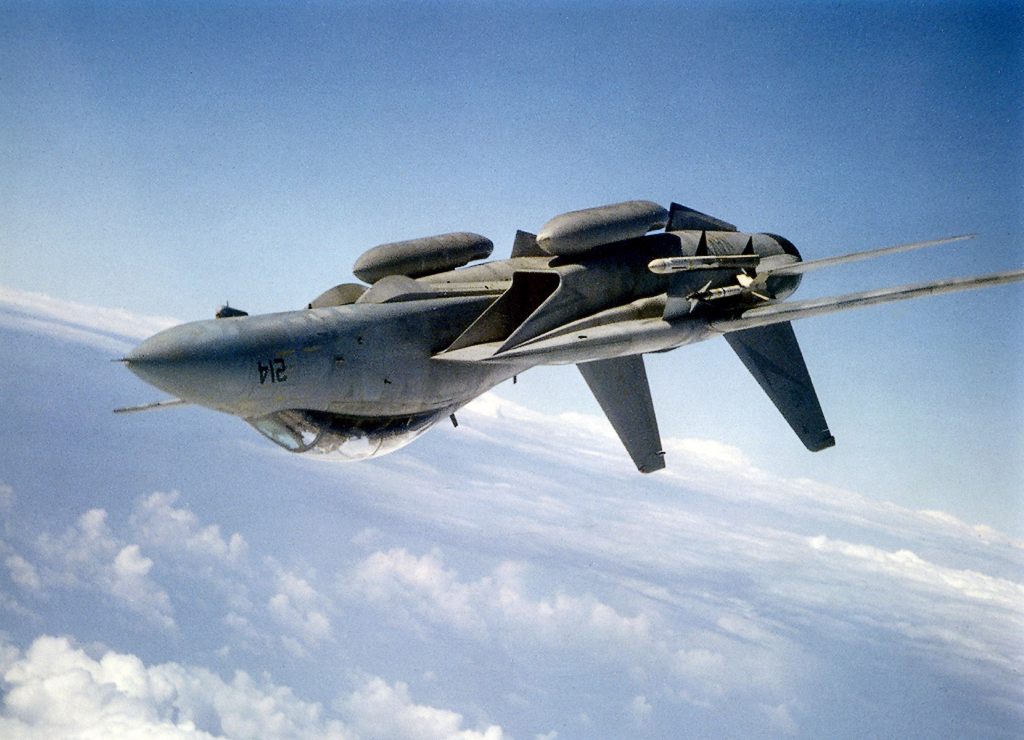
Attempting to use the environment and vertical separation to make us harder to see, I brought the nose on and had a speck in the target diamond on the heads up display (HUD). By about 2 miles the bogey had spotted us and turned nose on, and just inside of a mile I was able to visually identify (VID) him as an A-4E Skyhawk. Our game plan was set.
We passed left to left, turned left just far enough to keep him in sight, unloaded, accelerated and attempted to build separation. As the bogey’s nose was coming around towards us and approaching three miles separation, I went to idle power and extended the speed-brakes to slow rapidly to about 350 knots so that the Tomcat would turn at a good rate and small radius. The difficulty now would be to maintain sight of the relatively tiny A-4.
At three plus miles of separation and nose on, the A-4 was a speck as we looked over our left shoulders about 160 degrees aft of the direction we were heading. We had the separation; it was now time to pitch back and shoot the A-4 in the face. The hard part would be maintaining sight. It was difficult enough while extending away, but now smack 6.5 Gs on and it would be infinitely more difficult, but we were successful.

As our nose approached the A-4, my Radar Intercept Officer (RIO) in back got a radar lock on the A-4. With a AIM-9 Sidewinder missile selected, the missile’s seeker head immediately slaved to the radar track. We got a shrill tone indicating the seeker head had acquired the A-4’s heat signature. At about a mile and a quarter nose-to-nose, I squeezed the trigger on the stick grip and called “Fox 2.” After a few seconds the A-4 “Goon” driver called “that’s a kill” followed by “knock it off.”
It wasn’t the most glamorous and flamboyant way to kill a subsonic but highly maneuverable bogey, with stalls and spins and groveling gunshots, but it was effective, lethal and it was what Topgun taught. It required discipline, skill, and it was much more challenging than the former approach.
We were ecstatic! The A-4 was at bingo fuel from waiting on us, and we were at bingo fuel from our high speed transit to the restricted area. He joined up on our wing and we, as the victors, led him back to the overhead break at Naval Air Station Miramar. The speed limit coming into the break was 325 knots. We probably deserved a speeding ticket that day!
Alpha Strike
Another memorable flight at Topgun was our final event called an “Alpha Strike.” I think the name originated during the Vietnam War where certain targets were designated “Alpha” targets and large coordinated strikes were conducted against them. By the end of the class we had gone from working together as a crew flying 1 V 1 engagements, to working as a section with another crew from our sister squadron, VF-211, to working as a division with four fighters. For the Alpha Strike we would combine two divisions plus our Air Intercept Controllers (AICs) who were going through the class with us.

The strike took place on the ranges south and east of China Lake Naval Air Station, so there was also a surface-to-air threat simulation present. And then there was the always difficult group of Topgun bogeys providing an air-to-air threat. As a class we planned the strike and then on the next to the last day of the course, we flew the mission.
With several aircraft representing the attack package, eight fighters, and what seemed like an unending stream of bad guys, we executed the strike amid simulated surface-to-air missiles flying. There were aircraft everywhere. We then all returned to Miramar for our final debrief. With so many aircraft involved, it was a challenge for any one person to know everything that happened exactly, or to debrief it. The range was not instrumented so we would have to rely on our own individual accounts to piece the battle together.
Each fighter crew went through what they had seen and done, and then the bogey drivers stepped in with what they saw. In the end, we were able to put together a reasonable reconstruction of what had had occurred. Overall our strike had been a success, but there were lessons learned especially in the areas of timing and communications. The beauty of the Topgun debriefing style was that it was impersonal. Lessons were learned in a non threatening environment, and the debrief was a positive learning experience. It reinforced the positive things that had occurred, and looked for ways to improve things that had not gone so well. That night we had a class party with numerous skits put on by the students and staff.

The next morning we graduated. We didn’t win the Topgun trophy, and neither did any other crew. There was no such thing…at least not until the movie came out. Topgun had truly been a life changing event for me. A lot of things about flying and fighting jets, and using them to project power had come much more clearly into focus during my short visit there.
Fighting Topgun’s aggressors with the Tomcat
I had previous experience fighting F-5s and A-4s from my time at the Replacement Air Group and also from my time at VF-24. They could both definitely be a challenge. Every aircraft has its strengths and weaknesses. In roughly the first 40-50 years of air combat, most fighters were evaluated based upon speed and altitude capability. Also during that time, their weapons, guns and early infrared missiles, were primarily effective from behind the target, saddled in at close range. By the 1970s and 80s we had forward-quarter capable missiles that were effective, but sometimes unreliable. As a result, we simulated forward quarter shots, but often didn’t call kills except for rear quarter shots.
As Topgun came into existence due to poor air combat experiences in Vietnam, they started looking at other measures of aircraft performance, namely turn rate and turn radius. The speed at which an aircraft gets its best turn rate with minimum turn radius and no loss of energy is called its “corner” speed. For a given aircraft, this speed varies with altitude; slower at lower altitudes and increasing at higher altitudes. Having said all of that, with a neutral start, an aircraft with a slower corner speed (and smaller turn radius) and equal turn rates should start working further and further behind an aircraft with a higher corner speed (and larger turn radius), eventually getting it into position for a gun or aft-quarter missile shot.

An aircraft flown below its corner speed could decrease its turn radius (good), but would also decrease its turn rate (bad). Flown above corner speed it would normally increase its turn radius (bad) and rate (bad). Since the A-4s and F-5s flown by Topgun couldn’t match the F-14s ability to turn, their tactic was almost always to increase their turn rate by bleeding energy, and end up in an offensive position, but much slower (lower energy) than the F-14. The F-14’s advantage was its ability to add energy and extend away horizontally or vertically and then employ all aspect missiles. So intimidation was one of their key tactics.
The A-4 and F-5 had several other advantages. They were both extremely small and difficult to keep track of especially nose on to a fighter whose crew would most likely be under high G forces. Additionally, for the subsonic A-4 which lacks an afterburner, it could easily fly for more than an hour at full military power. The F-14, with 16,000 pounds of fuel at takeoff, could burn close to 2,000 pounds of fuel per minute in full afterburner. As a result, the F-14 had very little engagement time, much less any time to grovel. It was a losing proposition.

Ultimately to be successful in the F-14, a crew was required to be disciplined and precisely fly the Tomcat to defeat the F-5 and A-4. It needed to get in, take its shots, and get out. Another realistic advantage that the bogeys virtually always had was numbers. Flying the Tomcat, you could always plan on being outnumbered by the bad guys who were difficult to gain and maintain sight of, and you had to know that they could easily keep sight of you. Consequently you didn’t want to grovel and you didn’t want to stick around long. And finally to top it all off, these aircraft were being flown by the best bogey drivers out there bar none.
Returning to a fleet squadron as a Topgun graduate
We graduated on Friday morning, walked back out past the dumpsters into the parking lot, and drove back to VF-24, which was also based at Miramar. We spent a good bit of the afternoon wandering around the Maintenance spaces thanking the sailors who had supported us and given us good aircraft throughout the course. Additionally we had a month and a half’s worth of work to catch up on.
Fortunately VF-24 had several Topgun graduates, and two senior officers who were former Topgun instructors. Consequently the information that we had learned while attending Topgun was highly sought after and wholeheartedly accepted by all members of the squadron. Within several months, I assumed the job of Pilot Training Officer. Through this position, I was able to share the information that I had learned with the rest of the squadron.
Part of the charge as a Topgun graduate was to “talk the talk”, and we were both able to do that with lectures and briefings. The other part of the charge was to “walk the walk”, and we did that through the way we briefed, flew, and debriefed our flights. There was no way that Topgun could have direct exposure to all squadron pilots and RIOs in the fleet, so they trained the trainers who then went back to the squadrons and trained the remainder of the pilots and RIOs. Given the small amount of assets available, it was a very effective way of accomplishing such a goal.
Learning to be the teacher
If you think walking into Topgun as a student might be a humbling experience, try walking in as a new instructor. The one comfort zone that I had, flying the F-14, was now gone. Quickly I was given a ground job in maintenance, but unlike the fleet, I did very little towards that job. I had a Chief Petty Officer working for me, and he took care of everything. The two immediate priorities were to get qualified to conduct a lecture and get checked out in one of two aircraft, the A-4 Skyhawk or F-5 Tiger.

I was assigned the “Course Rules” lecture and given about six weeks to be prepared for my final “murder board.” Course Rules was about an hour review of all of the airfields and areas where the students might operate over the duration of the class. I received a pass-down from the instructor who had been conducting it, and then was on my own to research the presentation and make any changes I felt necessary. I then spent countless hours preparing to present it to the Topgun staff who would critique, or “murder” every aspect of the presentation and decide if I was ready to present it to a class.
Passing murder boards was nowhere near a given; many had to be repeated. It was a terribly rigorous process. Fortunately I did pass the murder board. During my time as a Topgun instructor, I would eventually pass Course Rules on to a new instructor, take over a lecture on Combat Gunnery, and develop a completely new lecture on Threat Tactics. Taking on new lectures never got any easier, in fact it was just the opposite. The more qualified you got and the more involved you got in the day-to-day operations of Topgun, the less time you had to take on a new lecture. New lectures involved many 16 to 18 hour days, and weeks without a day off. It was amazing the standards that we held ourselves and each other to in an effort to uphold the reputation of the school.
From a flying standpoint, I first checked out in the A-4E. The syllabus was called Familiarization/Tactics or FAM/TAC. It consisted of 12 to 15 flights. Because Topgun had no two seat A-4s at the time, I seem to recall going to VF-126 for three or four TA-4 rides to get an A-4 NATOPS qual (qualification). In addition, I completed VF-126s spin recovery training in the T-2C Buckeye. The beauty of that training was that while in the T-2C, you could use whatever spin recovery procedures your particular aircraft used, and it would recover from both upright and inverted spins. After that, the syllabus was comprised of multiple 1 V 1 flights with FAM/TAC instructors flying A-4s and F-5s.

Although building experience flying and fighting the aircraft was a big part of the syllabus, there was a huge emphasis on briefing, leading, and debriefing the flight. Once in a restricted area, a typical FAM/TAC flight would consist of an eyeball calibration, a snapshot drill, and then multiple air combat maneuvering (ACM) engagements, usually 3 to 4.
For the eyeball cal, we would start about a half mile abeam and then slowly separate with the leader calling out ranges out to about 2 miles. It was important for fighter pilots to be able to estimate ranges visually to determine when they were within missile and gun envelopes.
The snapshot drills consisted of two aircraft starting out about a mile abeam and then flying a weaving pattern with one practicing a high angle off snap shot with the gun on each merge. It was good to see from an offensive standpoint when a high angle off gun shot might present itself, and from a defensive standpoint to see when you might be susceptible to a high angle off, but potentially lethal gun attack. We also practiced defending against gun snap shots.
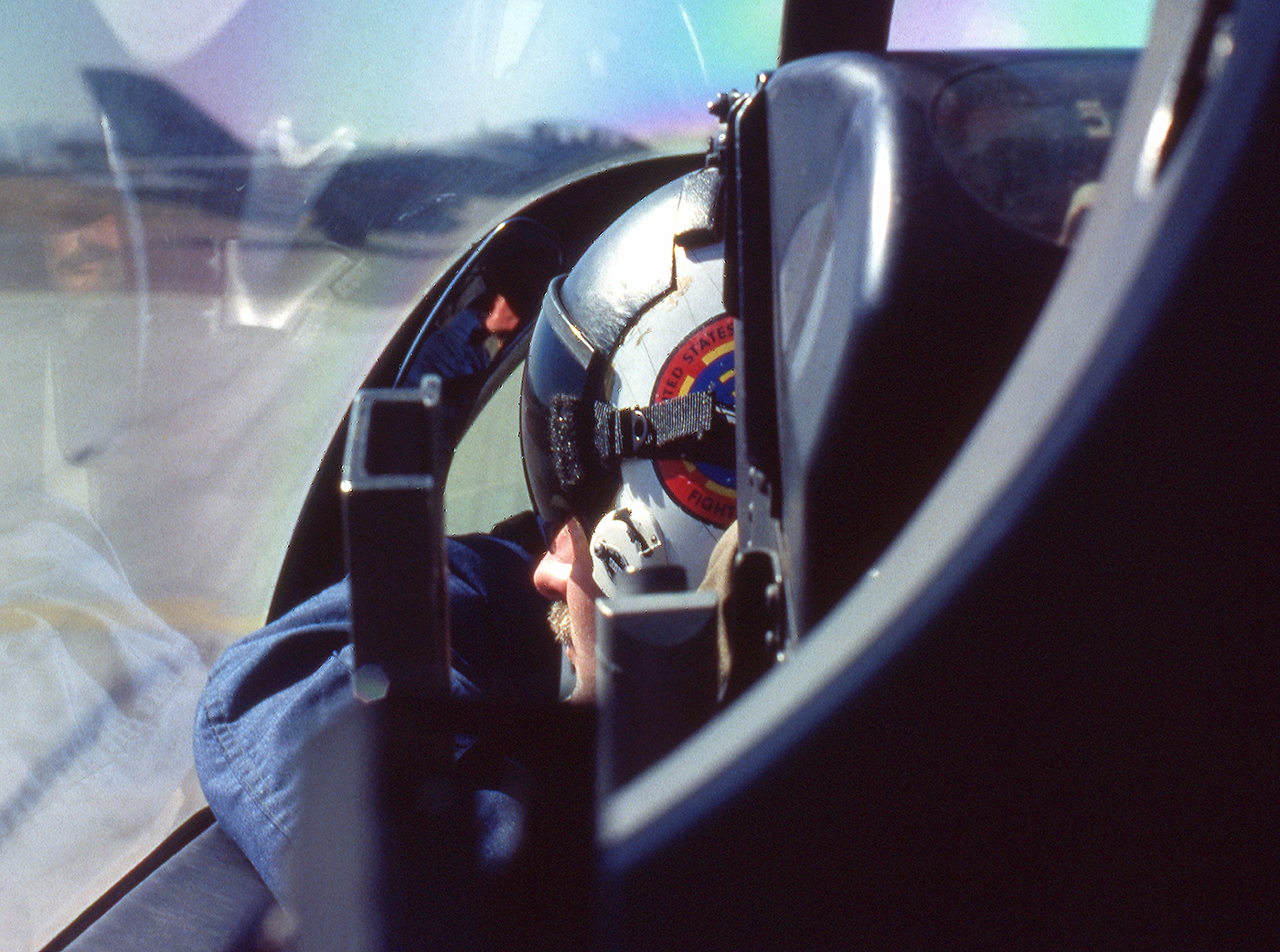
As a FAM/TAC student instructor, it was your job to orchestrate all of this and keep your flight within the restricted area along a certain TACAN radial between two different DME distances. We would then set up for the ACM engagements, usually commencing at about 20,000 feet, 300 to 350 knots, and a mile to a mile and a half abeam. Typical engagements would last anywhere from a minute and a half to three or four minutes. “Knock it offs” usually were the result of a valid shot, a neutral stagnation of the fight, or a successful disengagement (bug out) by one of the aircraft. The student instructor would then get the aircraft back together and on a heading to remain in the area. At the same time both aircraft would be climbing back up to the starting altitude of the next engagement and getting the speed set. As if that wasn’t enough, simultaneously each pilot would be writing notes on a card on their kneeboard about the previous engagement, for debriefing purposes. Successive engagements would occur until the first jet reached bingo fuel and then the student instructor would lead the flight back home.
As I was getting started in the FAM/TAC syllabus, there was a break between Topgun classes and a gun detachment (det) was planned to NAS Key West. The F-5’s had operable guns, but the A-4 did not. Even though I had yet to get checked out in the F-5, I went on the det as all of the instructors were going and also the squadron took the A-4s so we could conduct FAM/TAC from there.
One of my early FAM/TAC flights out of Key West was against another A-4 flown by the Topgun Training Officer. He was a Marine and long-time veteran of Topgun, so I was excited to fly with him. We took off, crossed the white sandy beach which gave way to the beautiful turquoise waters of the gulf, and headed for our operating area. Little did I know that on this day I would be exploring the edges of the envelope, of the aircraft…and of myself.
We made our way out to the restricted area conducting our eyeball cal and snapshot drill enroute. Once in the area we flew two or three engagements to knock it offs, and having enough fuel remaining, set up for one more. Fairly quickly this engagement turned into a vertical fight. I don’t really remember either A-4 having an advantage over the other, but I do remember starting up with the other A-4 topping out several thousand feet above me.
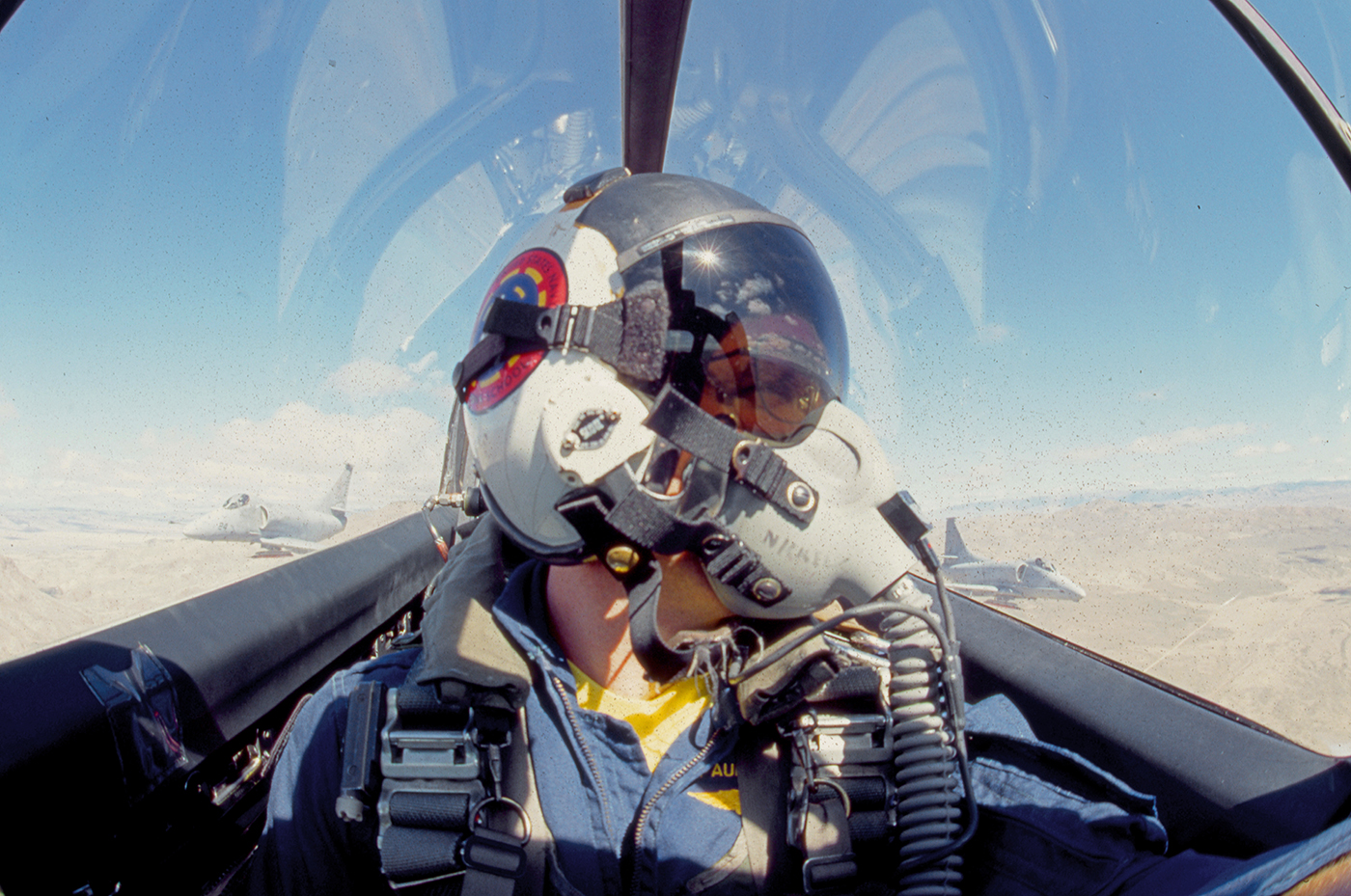
There was a caution in the A-4 NATOPS flight manual about running the jet out of airspeed with the nose 90 to 110 degrees nose high. In other words with the nose pointed anywhere from straight up to on its back, basically within 20 degrees of straight up. I was totally focussed on the other A-4 above and as he started tracking down toward the horizon, I realized that my nose movement was slowing rapidly. Pointed pretty close to straight up, it stopped…and then all was quiet.
You’re never conscious of the air noise in an aircraft…until it is silent…and then the silence is deafening! I was now exploring the caution area described in the manual, and was about to learn why there was a caution about it! I neutralized the controls, reduced the power, locked my harness, and ran the stab trim down to about two degrees nose up. At the same time I raised the flaps. By this time I was falling with the nose still high, but then it started slicing down and to the right. Finally! The nose was starting down towards earth so I could regain some airspeed. To my amazement, as it came slicing down through vertical it kept right on going back up toward the horizon and at the same time the jet was rolling upside down.
As it got close to the horizon and I was staring straight down through the top of the canopy at the turquoise water, I realized that the nose was now starting to move laterally close to the horizon. There was a dull audible cycling whine beginning, and it was getting louder and cycling faster. To this day I don’t know if it was a real noise, or just something created in my inner ear by the forces. It quickly became obvious to me that I was entering a spin, and it was getting quite violent. I was being tossed around the tiny cockpit in every direction. Most of the time my view was water, while hanging from the straps, but at times it was blue sky with my butt firmly planted in the seat.
I checked the AOA gauge and it was flopping from pegged high to pegged low, thus I couldn’t tell for sure if it was an upright or inverted spin, although I think in eventually settled into an inverted spin. I had done the things I needed to do to avoid a spin, but now it was time to counter it. Checking the turn needle, it was pegged to the right. I put in full left rudder. The airspeed was well below 100 knots. Checking the altimeter I was approaching 10,000 feet. Meanwhile my instructor saw what was happening and was chasing me down in his A-4. Several more rotations went by and at that point he told me I was at 10,000 feet and called for me to eject.
Things went into slow motion. The conflicting emotions of defeat, distress, fear, disappointment, dread all weighed heavily. It was hard to accept that this was really happening…this was a perfectly good aircraft and the last thing that I wanted to do was leave it in the Gulf of Mexico!
During the brief moment of this nuclear explosion of emotions in my brain, I suddenly realized that things were changing. The frequency of the cycling whine was slowing, the nose was getting lower below the horizon, and that beautiful air noise was starting to replace the diminishing whine. I slowly relaxed the left rudder, rolled back upright, and called out over the raidio, “I got it, I got it!!!” Now with flying speed I shoved the throttle to the stop, pulled back on the stick and bottomed out somewhere slightly above 5,000 feet.
My instructor joined up and said, “let’s go home!” I, my jet, and my instructor had been through a lot in the last few minutes. Getting back on deck safely was the order of the day. After parking, I wrote the aircraft up for an over-stress inspection; 6 positive Gs, 2.4 negative Gs. Maintenance ultimately had to replace several of the major bolts of the fuselage. We debriefed the entire flight, then called it a day.

That evening at the Staff Meeting (STAFFEX), with no advance notice, I was asked to tell the story. Being the new guy, it was very intimidating, but the other instructors asked questions and were genuinely interested in the details. No one gave me a hard time. The biggest lesson that I learned and used the rest of my time in the Navy was that in a situation where you run out of airspeed while nose high, don’t quit and let the aircraft do what it’s going to do. The nose has to come down, but you’ve got to control the rate. If it’s developing a high pitch or yaw rate while coming down, counter it with stick or rudder so that it doesn’t go right through the vertical and back up toward the horizon with no airspeed. That worked well for me both in the A-4 and F-5 on a number occasions. No longer would I sit back and let it do its thing.
To this day, any time I fly near tropical turquoise waters, I flash back to that A-4 cockpit with those beautiful waters spinning up above me as I fell out of the sky toward them, and it haunts me. I had survived again, living by the old aviation adage, it’s better to be lucky than good!
How to fight and win in the F-5 and A-4
I completed the A-4 FAM/TAC syllabus and was able to fly with the next class, at least in the multi bogey events. I was now a full up instructor, but I still had to qualify in the F-5. Over the next couple of months I was able to complete the FAM/TAC syllabus in that jet also.

The second FAM/TAC syllabus was definitely easier than the first, since I had already become proficient in briefing, leading, and debriefing from the first aircraft syllabus. Once checked out in both aircraft, probably the biggest advantage Topgun instructors had was time in the jets. We had plenty of money for flying, and we had great maintenance personnel who kept our machines up and running. Virtually all of our time was ACM. While classes were in session, most of our flying was with the class. However in the weeks between classes we supported the fleet working out of Miramar and other Navy and Marine bases that had Hornets and Tomcats, and also supported air wing dets at NAS Fallon in Nevada.
By the time I was an instructor, all of the Topgun class aircraft were either F-14’s or F-18’s, both of which were superior to the A-4 and F-5. However, the A-4 could hold its own with both, if it could get them to slow down, which it usually did through intimidation.
The A-4 had aerodynamic leading edge slats which once deployed would significantly help its turn rate at slower speeds. Unfortunately sometimes they would deploy asymmetrically causing a rolloff at the worst of times tactically. Additionally we used the flaps a great deal at slower speeds. There was a three position flap handle, up, down, and hold, located near the throttle that could be used to gradually lower the flaps as the airspeed decreased.

Probably the biggest advantage available was trimming the horizontal stabilizer. The elevator on the trailing edge of the stabilizer was tiny compared to the overall area of the stabilizer. Trimming the stabilizer up helped greatly in keeping the nose up at slow speeds. I would usually wear a hole in the right thumb of my leather flying gloves every couple of months from working the trim button so much while fighting in the A-4. Additionally our A-4s were stripped of unnecessary parts, giving them the best thrust to weight ratio possible. All in all, it was a very good simulator of the MiG-17.
If the A-4 pilot could maneuver aggressively and out of plane enough to intimidate the fleet fighters and get them to slow, it had a fighting chance…and with no afterburner, it could fight for a very long time. Additionally a great advantage of both the A-4 and F-5 was their small size, especially when viewed from nose or tail on. It was much easier for the bogeys to keep sight of the fighters than the reverse.
The F-5 was like a sports car. You wore a survival vest and G suit when you flew it, and hauled a parachute out from the parachute rigger (PR) shop. After putting your chute in the seat, you literally walked around it, kicked the tires, hopped in and lit the fires! It was so simple.
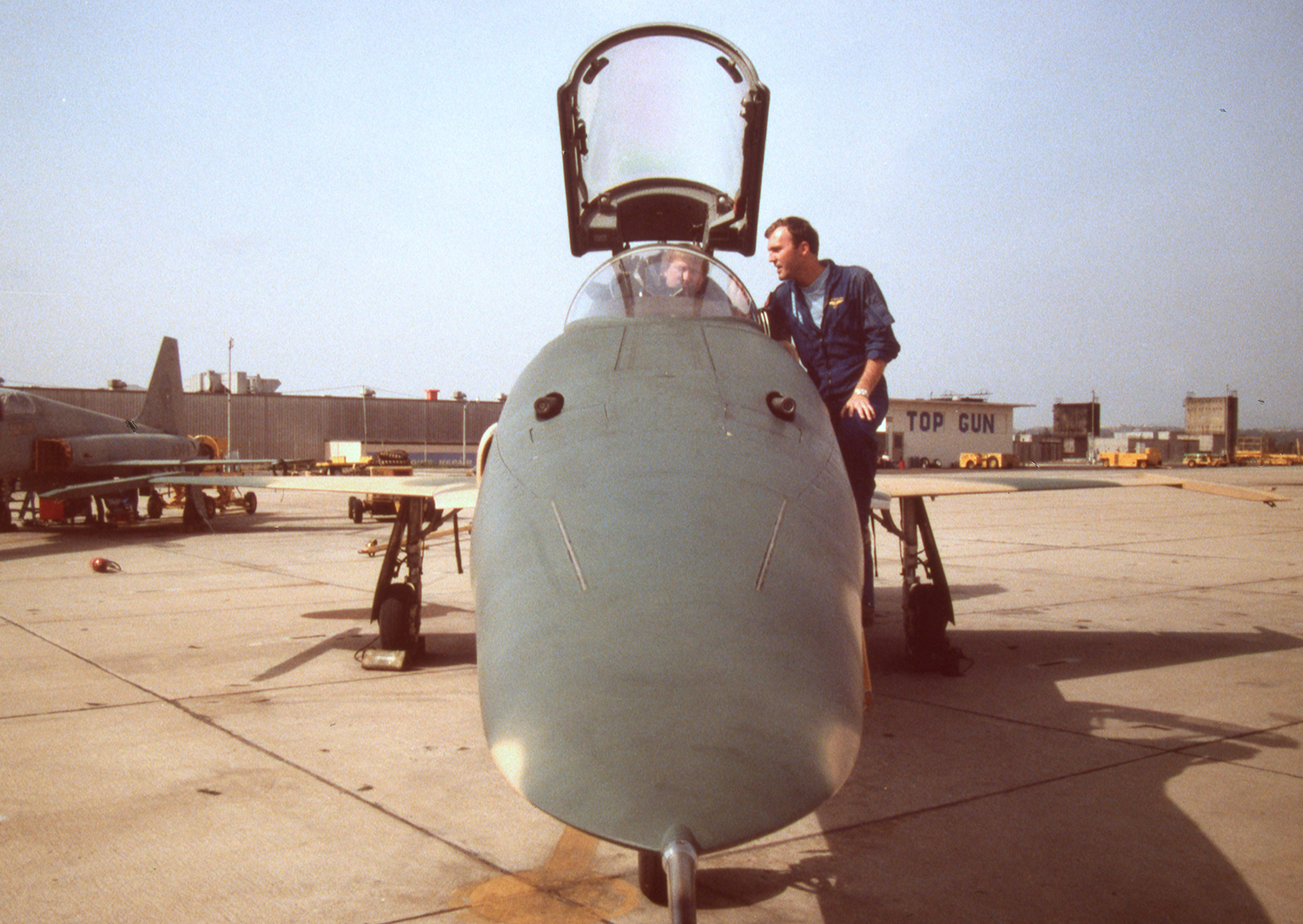
Although it had a very small cross section nose on, the fuselage was significantly wider than the A-4, so the cockpit was much wider and seemed spacious. It had a higher wing loading than other aircraft that I had flown, thus its takeoff and approach speeds were noticeably faster. It was not a good aircraft for landing on wet runways, and had a drag chute just in case. Fortunately at Miramar we had little rain and a 14,000 foot runway.
The F-5 was a much better simulator of the MiG-21. It had maneuvering flaps and slats controlled by a thumb switch on the throttle which would help as it got slower. When simulating a MiG-21, we would normally limit it to rear quarter IR missiles and guns. Flown well, it could give the F-14 and F-18 a good fight initially, but would lose the battle if they managed their energy well. It was also fuel restricted and could not grovel for long periods like the A-4.

Because of its afterburner and supersonic capability, it could be an effective simulator of the MiG-23 if flown accordingly; high speed and relatively low G. We would normally use it in later class missions to simulate some of the newer Soviet threat aircraft with forward quarter capability. However, with no radar it was very difficult to simulate these threats and shots effectively unless on instrumented ranges which were often unavailable. We were definitely aware of the newest Soviet fighters and their capabilities, and the fact that they were being exported to third world countries. We did the best that we could do with the equipment that we had, but it was becoming a losing battle attempting to simulate the newer threats. Fortunately those that had come ahead of us had the foresight to plan for a more capable threat simulator.
Read all about that incredibly unique aircraft, the F-16N, and Paul’s time flying and fighting in it as a Topgun instructor in part one of the Paul Nickell series linked here.
Contact the editor: Tyler@thedrive.com
